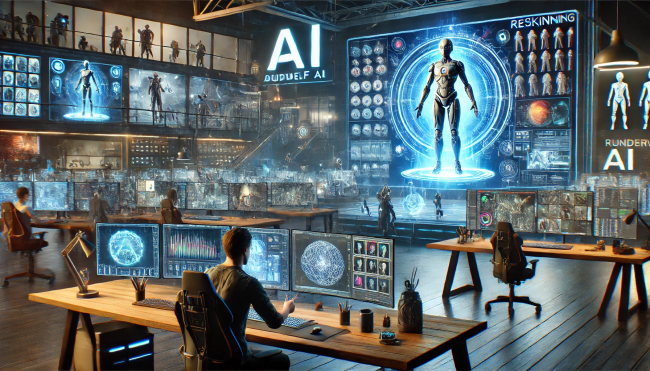RenderWolf AI: Revolutionizing Game Development and Digital Content Creation

The rapid evolution of artificial intelligence (AI) has made significant strides in various industries, including game development, digital content creation, and design. One of the most advanced tools in this space is RenderWolf AI, a game-changer that streamlines and accelerates asset creation for game studios and digital creators alike. In this article, we’ll explore the various features, applications, and benefits of RenderWolf AI, diving deep into how this innovative technology is reshaping the future of game development and content creation.
What is RenderWolf AI?
RenderWolf AI is an advanced AI-driven platform designed to assist game developers, designers, and digital content creators by automating asset generation processes. The platform allows developers to create, reskin, and evolve game assets quickly while maintaining artistic consistency. RenderWolf AI is built to integrate with popular development tools such as Unity and Unreal Engine, offering flexibility and compatibility for game studios of all sizes.
The Core Features of RenderWolf AI
RenderWolf AI boasts a variety of features that make it an indispensable tool for content creators and game developers. Some of the most prominent features include:
1. AI-Driven Asset Creation
RenderWolf AI is capable of creating high-quality assets based on user-defined parameters. Whether it’s textures, character models, or environmental assets, the platform generates content that fits seamlessly into a game’s style and aesthetic. The AI can design humanoid and non-humanoid characters, clothing, weapons, and accessories, helping developers meet project deadlines faster.
2. Texture and Material Generation
One of the most time-consuming tasks in game development is creating textures and materials that align with the game’s overall art direction. RenderWolf AI simplifies this by generating realistic textures, whether for rugged terrains, organic environments, or smooth metallic surfaces. This helps developers save time and resources while maintaining high-quality outputs.
3. Level Design and World Building
Level design is a complex process requiring creativity and technical expertise. RenderWolf AI assists by generating layouts, placing assets, and even suggesting gameplay elements like enemy placements or puzzle mechanics. For developers working on large-scale open-world games, this feature provides significant time savings and ensures the creation of intricate, engaging environments.
4. Asset Reskinning and Evolution
Game studios often need to refresh in-game content to keep players engaged. RenderWolf AI offers the ability to reskin existing assets into new themes with minimal manual intervention. Moreover, the platform allows for the evolution of assets, enabling game environments and characters to progress as players advance through the game. This adaptability is particularly useful for live-service games that require regular updates and content releases.
5. Real-Time Feedback and Collaboration
RenderWolf AI offers real-time feedback on the assets it generates, allowing developers to make immediate adjustments. This is especially valuable during prototyping and testing phases, as developers can quickly iterate on their designs. The platform also supports team collaboration, with enterprise-ready workflows that make it easier for multiple team members to work on a project simultaneously.
The Benefits of RenderWolf AI for Game Developers
RenderWolf AI offers numerous advantages for game developers, ranging from increased efficiency to enhanced creativity. Below are some of the key benefits that have made this tool a favorite among game studios:
1. Speeding Up Development
Traditional asset creation is a labor-intensive process that often requires a large team of artists and designers. RenderWolf AI automates many of these repetitive tasks, reducing the time it takes to develop game content. This allows developers to focus on more complex and creative aspects of game design, such as narrative development and gameplay mechanics.
2. Cost Efficiency
By automating asset generation, RenderWolf AI helps studios cut down on labor costs. Smaller teams can achieve the same level of output as larger teams, making it an excellent solution for indie developers or studios with limited budgets. The cost savings extend beyond labor as the platform’s optimization tools ensure that assets are designed efficiently, reducing the need for costly revisions later in the development cycle.
3. Consistency and Quality Control
Maintaining a consistent art style across a game is critical to providing an immersive and cohesive experience. RenderWolf AI ensures that every asset it creates meets the same high standards, regardless of when it was generated or who initiated the process. This level of consistency enhances the final product’s visual appeal, making for a more polished game.
4. Flexibility and Adaptability
The gaming industry is fast-paced, with trends and player preferences evolving rapidly. RenderWolf AI’s ability to reskin and evolve assets allows developers to keep their games up to date with minimal effort. Whether it’s introducing new themes for special events or updating characters as players progress, the platform provides the flexibility developers need to stay competitive.
RenderWolf AI in Different Game Development Scenarios
RenderWolf AI’s versatility makes it applicable in various stages of game development, from indie projects to AAA titles. Below are some scenarios where RenderWolf AI can make a significant impact:
1. Indie Game Development
Indie developers often face the challenge of producing high-quality content with limited resources. RenderWolf AI allows these developers to compete with larger studios by automating asset creation. This can be especially useful for creating procedural content, which is a common feature in indie games. For instance, an indie developer can quickly generate hundreds of unique characters or environments, saving valuable time.
2. AAA Game Development
For larger studios working on AAA titles, the scale of the game world and the number of assets required can be overwhelming. RenderWolf AI helps by generating assets at scale while maintaining artistic quality and performance optimization. For example, in a recent AAA open-world game project, RenderWolf AI was used to generate hundreds of buildings, landscapes, and character models, drastically reducing the development timeline.
3. Live-Service Games
Games with live operations, such as MMORPGs or mobile games, require frequent updates to keep players engaged. RenderWolf AI’s asset reskinning and evolution features allow developers to quickly introduce new content, ensuring that the game remains fresh and exciting without requiring significant manual input. Studios can also use the platform to experiment with new themes and assets for seasonal events or updates.
4. Educational and Serious Games
Educational game developers often need a diverse range of assets to represent various learning concepts. RenderWolf AI provides a quick and efficient way to generate these assets, allowing developers to focus on creating engaging and educational content. The platform’s ability to evolve assets also supports the development of interactive, evolving learning environments that adapt to the student’s progress.
Challenges and Limitations of RenderWolf AI
While RenderWolf AI is a powerful tool, it’s essential to understand its limitations and challenges. These include:
1. Technical Limitations
RenderWolf AI, like any AI-driven platform, has technical limitations, particularly when dealing with highly complex or abstract designs. In some cases, human intervention may be needed to refine AI-generated content to meet specific quality or artistic standards.
2. Risk of Reduced Artistic Control
While the AI can generate assets quickly, there is a risk that relying too heavily on AI-generated content could lead to a loss of unique artistic identity. Developers must find a balance between automation and manual design to ensure the final product maintains its creative vision.
3. Ethical Considerations
The use of AI in game development raises ethical concerns, particularly regarding job displacement. As AI tools like RenderWolf become more prevalent, studios must consider how to retrain and support workers whose roles may be affected by automation.
The Future of RenderWolf AI and AI in Game Development
As AI continues to evolve, RenderWolf AI is poised to play an even more significant role in the future of game development. Here are some trends to watch:
1. Integration with Augmented and Virtual Reality
As AR and VR technologies become more mainstream, RenderWolf AI could evolve to support the creation of assets specifically designed for immersive experiences. This would allow developers to create more interactive and dynamic virtual worlds.
2. Enhanced AI Creativity
Future developments in AI could see RenderWolf AI becoming even more creative, generating truly unique and innovative designs that push the boundaries of what’s possible in game development.
3. Collaboration Between AI and Human Artists
Rather than replacing human artists, RenderWolf AI is expected to facilitate greater collaboration between AI and humans. The AI could handle repetitive tasks, allowing artists to focus on more creative and conceptual aspects of game design.
Conclusion
RenderWolf AI is revolutionizing the way digital content and game assets are created. Its ability to automate time-consuming processes, maintain artistic consistency, and adapt to evolving trends makes it a powerful tool for developers and creators. While there are some challenges, the benefits far outweigh the limitations, especially as the technology continues to improve. As AI becomes more integrated into the creative process, tools like RenderWolf AI will play a crucial role in shaping the future of game development.



